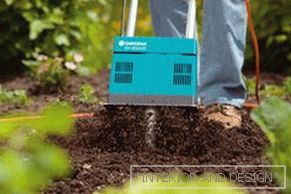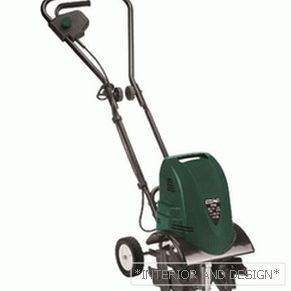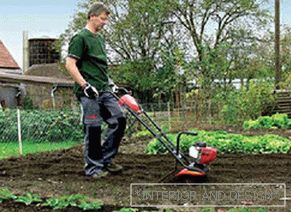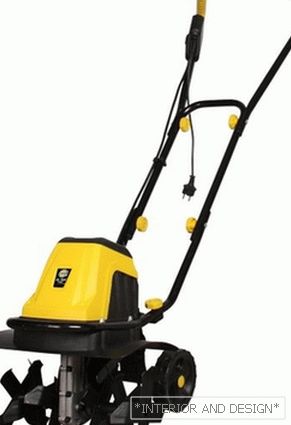 Each land owner knows how much effort is needed in preparing the soil for planting crops, as well as in the subsequent processing of the beds: weeding and cultivation. Moreover, the older a person is, the harder it is for him to overload a load that takes a lot of energy and health. This problem is particularly relevant in the spring, which has always been and remains hot at times for summer residents. At this point it will be appropriate to purchase an electro-cultivator - a reliable assistant in garden work.
Each land owner knows how much effort is needed in preparing the soil for planting crops, as well as in the subsequent processing of the beds: weeding and cultivation. Moreover, the older a person is, the harder it is for him to overload a load that takes a lot of energy and health. This problem is particularly relevant in the spring, which has always been and remains hot at times for summer residents. At this point it will be appropriate to purchase an electro-cultivator - a reliable assistant in garden work.
Content
- 1 What is electro-cultivator and where is it used?
- 2 Varieties of cultivators
- 3 Device and principle of operation of electro-cultivator
- 3.1 The principle of electro-cultivator
- 4 How to make electro-cultivator with your own hands?
- 4.1 Sequence of actions
What is electro-cultivator and where is it used?
The electric cultivator is an electrically driven device designed to replace manual labor in tillage: when loosening the soil, fertilizing, bedding, weeding. Thus, it can be called a "mechanized chopper."
It should be noted that the unit is absolutely not designed to work on large areas or to raise virgin soil (as opposed to powerful "hard workers": a mini-tractor or a motor-block with a plow). But he will serve in flower beds, on small vegetable beds and in areas between garden trees. It captures a layer of earth with a depth of no more than 30 centimeters. Its task is to give the soil the necessary structure, prepare the soil for fertilizer application, aeration, weed control.
Thanks to nutrition by electricityThis unit is an absolutely environmentally friendly device, unlike its gasoline counterparts that run on gasoline, so it can be used in closed conditions (for example: greenhouses and greenhouses).
In addition, electro-cultivators have other benefits in comparison with gasoline tillers, namely:
- low weight devices (allows women and pensioners to use it successfully);
- compact dimensions (provide convenience during transportation and storage);
- ease of maintenance (does not require special skills);
- low cost (makes them available to a wide range of buyers)
Varieties of cultivators
 Garden cultivators are represented by a large variety of models that differ from each other in a number of ways.
Garden cultivators are represented by a large variety of models that differ from each other in a number of ways.
- By weight. Lightweight models have a mass - 9 kg-10 kg. The heaviest models can weigh up to 50 kg.
- By power. This parameter ranges from 1−2 l. with. up to 7−12 l. with. It should be borne in mind that more powerful units are able to cope with heavier soil.
- By purpose. In accordance with this feature are cultivators:
- steam (their task - continuous processing);
- universal (they can easily and inter-row processing);
- tilled (work for them - the cultivation of the soil and the destruction of weeds between the rows).
- By the number of mounted implements. Choosing a cultivator, first of all you need to decide on the range of work that the device will produce. Different nozzles are designed for different tasks:
- Hiller (device beds, hilling rows, the formation of furrows and spacing);
- mill (breaking and loosening the soil, weed control). Depending on the design, the cutter can be: needle-shaped, sickle-shaped or disk;
- digger (collection of root crops). He is able to undermine and lift the top layer of soil.
AT kit Some models may include attachments for processing soft soils, grass care, plowing.
By цене electro-cultivators are also different. The cost of electro-cultivators varies from 3 650 rublesfor example: cultivator
 При этом обе модели, указанные выше, имеют примерно одинаковый вес (9 кг и 9.5 кг), равные power (750 ATт), ширину обработки (30 см), 4 фрезы в наборе. Американский вариант отличается особенной (змеевидной) формой фрез и скоростью их вращения (240 оборотов в минуту). Такое устройство не только вспахивает землю, но и рыхлит ее, избавляет от сорняков, работает на глубине 25 см (при вспахивании) или 3 см — 10 см (при культивировании). Гарантийный срок эксплуатации — 2 года, но при разумном использовании прослужит гораздо дольше.
При этом обе модели, указанные выше, имеют примерно одинаковый вес (9 кг и 9.5 кг), равные power (750 ATт), ширину обработки (30 см), 4 фрезы в наборе. Американский вариант отличается особенной (змеевидной) формой фрез и скоростью их вращения (240 оборотов в минуту). Такое устройство не только вспахивает землю, но и рыхлит ее, избавляет от сорняков, работает на глубине 25 см (при вспахивании) или 3 см — 10 см (при культивировании). Гарантийный срок эксплуатации — 2 года, но при разумном использовании прослужит гораздо дольше.
The Russian invention has a diameter of cutters (provides plowing depth) - 22 cm. It differs in a particularly favorable price-quality ratio. Warranty period - 1 year.
If you consider more powerful a variant of the South Korean company Hyundai (Hyundai) T 2000-E, it differs from previous models in weight (30 kg), engine power (2000W) and soil width (55 cm). The unit has the cost of 13 000 rubles. Individual parts are reinforced with metal protection and have a warranty period from the manufacturer up to 100 years. Forged cutters used in this model also contribute to an increase in service life.
Device and principle of operation of electro-cultivator
Electric cultivator is a device consisting of an electric motor and a gearbox, which are placed on the frame. Working bodies (cutters and opener) are attached to the output shaft of the gearbox. The steering wheel with a handle is connected to the frame through an interface element. On the frame is fixed transport wheel. In some models, you can move the steering wheel and lock it in position.
The principle of electro-cultivator
 Through worm gear the electric motor transmits the torque to the working bodies (cutters). Thanks to sharp knives of mills high-quality processing of the soil is possible.
Through worm gear the electric motor transmits the torque to the working bodies (cutters). Thanks to sharp knives of mills high-quality processing of the soil is possible.
Plowing depth can be adjusted by a coulter, clamped with bolts or up-and-down the handle The width of the cultivation can reach half a meter, and the maximum plowing depth - 25 cm.
Average electrocultivators productivity is approximately 3 hundred square meters per hour, but the nature of the soil largely influences the value of this characteristic (sandstones are easier to process than loam). The speed of rotation of the knives - 50 revolutions per minute. Power consumption devices - up to 2 kW.
With the help of the steering wheel, connected through a mate with the frame, a person manages an electrocultivator. Thanks to a wheel the unit can be transported. Some models have the ability to steering wheel adjustment (in accordance with the physical data of the user or in connection with the peculiarities of the technological process, when a person must be on the side of the device and not walk on plowed soil)
How to make electric cultivator with your own hands?
 Для того, чтобы пользоваться всеми benefits механизированного труда, совсем необязательно приобретать мотоблок. Изготовить полезное приспособление может любой человек, более или менее знакомый с техникой.
Для того, чтобы пользоваться всеми benefits механизированного труда, совсем необязательно приобретать мотоблок. Изготовить полезное приспособление может любой человек, более или менее знакомый с техникой.
To work you will need:
- serviceable motor from the meat grinder;
- 2 pipes;
- corners;
- screw;
- wheels with axles;
- lm.
Instruments:
- welding machine;
- pliers, sledgehammer, hammer;
- keys set.
Byследовательность действий
- Screw 2 corners to the metal case of the gearbox.
- Bend the ends of the two tubes for comfortable handles, weld the pipes to the corners.
- Weld to the corners of the axle for future wheels. When choosing transportation elements, keep in mind that too large wheels will not be easy to drive, and too small - can get stuck and fall into the ground. Therefore, these items should be of medium size.
- Creating a shaft structure. Sledge hammer break the nozzle from the meat grinder. In the sleeve, place the workpiece from scrap.
- Privans screw-grouser.
- On one of the arms can be placed engine switch for more convenient use of the unit.
With the rapid movement of such a cultivator will break the earth into large clods. When slow processing unit helps to make the soil soft and loose, the work done will be neat.
Reviews users of electro-cultivators say that these devices are becoming increasingly popular among summer residents, regardless of who the manufacturer of the unit is: a well-known company or an independent assembly. The model is selected depending on the operating conditions (soil type), scope and nature of work.



